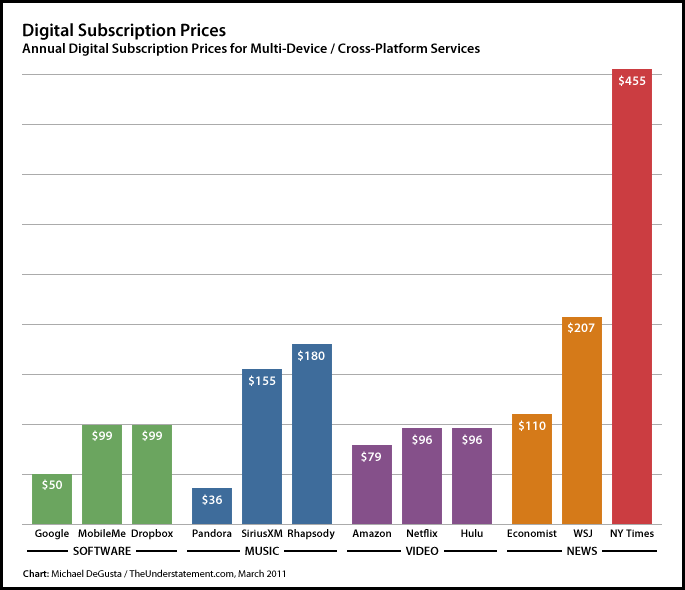New York Times Paywall Price Insane
Michael DeGusta compares the digital subscription prices of a variety of services and concludes that the New York Times is delusional.
Does The Times really think the mass audience is going to decide their $455/year is better spent on The Times rather than getting 20+ free articles/month from The Times plus The Wall Street Journal ($207/year) plus The Economist ($110/year) plus say The Daily ($39/year) for good measure, and still having ~$100 left over each year?
Apparently.
But Felix Salmon, who has been highly skeptical of the NYT paywall model, does see one possible upside: They may be able to charge more on a per-eyeball basis for advertising, persuasively arguing that people paying this much for access are “engaged” at a level non-paying readers aren’t. Then again, it’ll have to be a whole lot more per eyeball given that they’ll have markedly fewer of them.







How the New York Times would be worth more to subscribers than the Wall Street Journal, which produces a specialized product that appeals to a discrete group that is likely willing to pay for the content the WSJ produces, is beyond me.
This is hugely misleading. If you buy a subscription to the Website and a smartphone app together, it costs $195/yr, not $455.
Access to the website plus an Ipad app is $260/yr, not $455.
Its only if you want to read the Times on the web, on your smartphone, and on your Ipad at the same time does it get up to $455, because they make you buy both of the above subscriptions to get that full coverage. That is certainly an irrational policy, but it only applies to people trying to have access on all three platforms.
One presumes they are betting on the Collective. If you are not up on your NYT, then you are likely to be shunned from the Progressive community as a possible plant, perhaps even a Walker plant.
I’m not sure where the numbers come from, and they may well be insane, but I subscribe to the weekend edition of the Times, get Saturday and Sunday delivered to my house in paper format (and get most of Sunday’s paper on Saturday, very cool) and read on both my iPhone and iPad, with my understanding that this will continue after the paywall, all for less than $250/year.
JKB said “One presumes they are betting on the Collective. If you are not up on your NYT, then you are likely to be shunned from the Progressive community as a possible plant, perhaps even a Walker plant.”
Get real. Name one news source that has the boots on the ground that the NYT does. Remember when the Chinese were adding (what? someone help me here) to toothpaste, dog food and baby formula, resulting in pet deaths in the US and infant deaths in China? While everyone else was still “reporting” by standing outside government buildings or “covering the news” by having a bunch of suit wearing blowhards yammer on about this and ten other topics they know nothing about, the Times had 30 reporters, editors and photographers showing up at about a dozen Chinese production plants using the substance. And they got there before the plant managers knew there was a crisis so were able to get production personnel taking them through the usage step by step and hear the explanations of why they were using it.
All the right wing whiners that blather on about the “liberal media” and the “lame stream media” (and that certainly isn’t even a majority of right wingers), just reveal their ignorance when they compare the Times to something like, what, Fox News? C’mom, give me a break.
What the f— does that even mean? Sounds like bullsh*t to me. But hey, if it gets fools…errr people to part with their advertising dollars, more power to them.
@Steve,
Advertisers pay very low rates to most websites because most “visitors” are accidental–having followed a link and then leaving when not finding what they were looking for. Presumably, people who have paid to subscribe to a site actually intend to be there and, indeed, like the site enough to spend a lot of time there, clicking from page to page, etc.
But, to make up numbers out of whole cloth, let’s say NYT goes from $1 per thousand impressions to $10. That would be very high. But if the paywall cuts their readership 12-fold, they’d lose money.